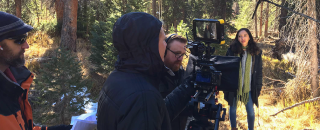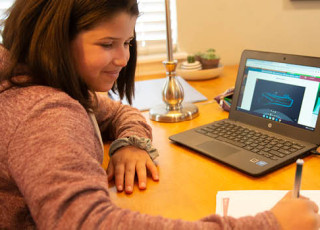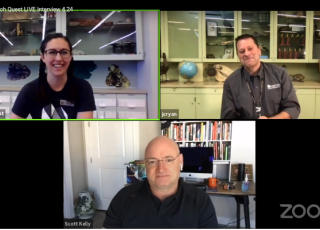The Natural History Museum of Utah Launches Four New Research Quest Investigations for Utah Middle School Teachers and Students
SALT LAKE CITY, Oct. 24, 2019 —What’s killing lodgepole pine trees in the Uinta Mountains? That is just one of the vital question’s students will be poised to answer in the newest set of the Natural History Museum of Utah’s Research Quest investigations launching at 10 a.m. on Thursday, October 24, 2019, at Glendale Middle School in Salt Lake City.
“Research Quest is a free online, standards-based resource designed for middle school teachers and their students,” explains Madlyn Larson, Director of Education Initiatives at the Natural History Museum of Utah. “It uses the Museum’s collections, as well as its research and scientists to promote critical thinking, communication, and collaboration skills while giving students the opportunity to work on authentic scientific questions.”
First envisioned in 2014 by a coalition of teachers and learning specialists, as well as scientific and digital experts, and made possible with the invaluable support of generous funders, the first Research Quest module, consisting of three investigations, debuted in Utah schools in January of 2016. Since then, more than 500 teachers and 50,000 students have engaged, gathered evidence, reasoned, and communicated theories surrounding the mysteries of Utah’s own Cleveland-Lloyd Dinosaur Quarry.
The latest Research Quest module, Change in the Uinta Mountains, Normal or Not? will be available in Utah and in classrooms across the country beginning October 24, 2019. The module, comprised of a set of four new investigations, is designed to engage students in the examination of change and stability in one of Utah’s montane ecosystems. In all, there are 19-scientist-led videos and 14 student interactives that support these investigations.
In the words of Mitchell Power, Curator of Botany at the Natural History Museum of Utah, “This project created an opportunity for me to share my passion for research and education with one of my favorite ecosystems in Utah, the Uinta Mountains. Research Quest has taught me what really matters to kids and how their perspective can teach all of us about changes we are experiencing in our own backyard.”
Isabel Perez-Vega, one of the key personalities in the new investigations – and a graduate of Glendale Middle School – says, “I feel very passionate about involving kids in science as early as possible, especially in non-traditional ways.”
Isabel first became involved with the Museum’s Youth Teaching Youth (YTY) program as a 7th grader at Glendale Middle School and continued in the program through high school. After high school, she started working at the Museum as a summer camp counselor and a birthday party host. Last year the Research Quest team recruited her to join NHMU scientist Dr. Mitchell Power as a co-host on the new investigation videos. Explaining her experiences with the Museum, Isabel says, “I really love the way the Museum encourages curiosity in its approach to educating people about the natural world.”
The Research Quest team plans to complete at least seven additional investigations in the next 18 months, with the support of grants and generous private funders.
The overarching goals of Research Quest are to:
- Advance critical thinking, collaboration and communication skills among young learners.
- Expand the catalog of Research Quest investigations to other topics and grade levels.
- Expand the number of teachers and students using Research Quest throughout Utah and beyond.
Research Quest will be highlighted in a local workshop for middle school teachers titled Phenomenon-Based Learning Using Digitized Museum Objects at the National Science Teachers Association taking place at the Salt Palace in Salt Lake City October 24-26, 2019.
Educators using Research Quest benefit from the easy-to-use instructional guides, student notebooks, assessment tools, and online investigations, which align with Next Generation Science standards (NGSS), Utah’s Science with Engineering Education standards (SEEd) and English and Language Arts standards (ELA).
According to Jennifer MacKay, a seventh-grade teacher at Riverview Jr. High in Murray, Utah, who has used the platform in her classroom, “Research Quest is a great tool when it comes to helping your students think and act like scientists. It is aligned with the new Utah SEEd standards. By completing Research Quest, students have the opportunity to be engaged with all the Cross-cutting Concepts. I would use it yearly in my teaching.”
To learn more about Research Quest or to sign up, visit http://researchquest.org.
###
Research Quest is made possible with generous support from the Joseph and Evelyn Rosenblatt Charitable Fund and the IJ and Jeanné Wagner Foundation. Their ongoing support, combined with a generous grant from the Utah Department of Workforce Services’ Utah Cluster Acceleration Partnership program, funding from the Utah State Legislature’s Informal Science Education Enhancement program, and a grant from the National Science Foundation, has allowed Research Quest to become a valued teaching resource for teachers and students throughout Utah and in states nationwide.
About the Natural History Museum of Utah
The Natural History Museum of Utah is one of the leading scientific research and cultural institutions in the country. Established in 1963, the Museum’s collections contain over 1.6 million objects and offers innovative exhibitions and educational programs to thousands of residents and visitors each year, including traveling and permanent exhibits, special events and other programs. With an expected attendance of 300,000 visitors a year, the Museum also offers a variety of outreach programs to communities and schools throughout Utah, reaching every school district in the state annually. The Museum has an active science program with more than 30 scientists and 10 field exhibitions each year.
Press contacts and links
-
Press Contact
Beth Mitchell



